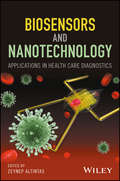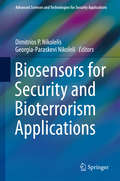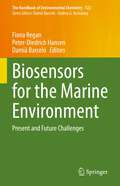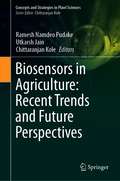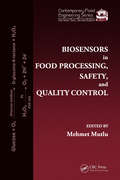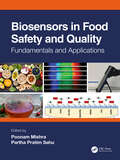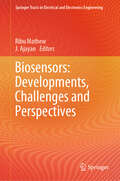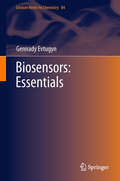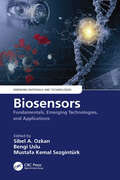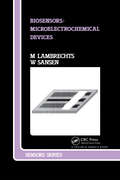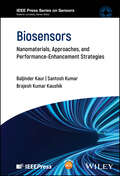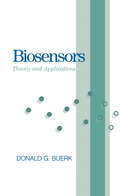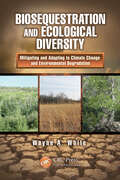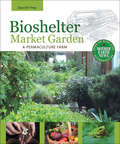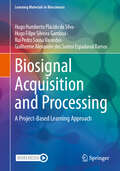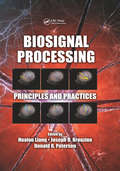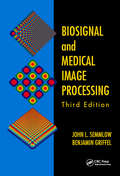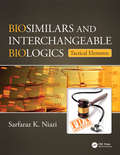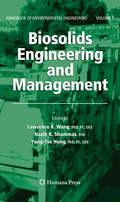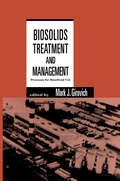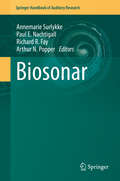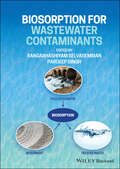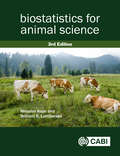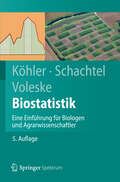- Table View
- List View
Biosensors and Nanotechnology: Applications in Health Care Diagnostics
by Zeynep AltintasProvides a broad range of information from basic principles to advanced applications of biosensors and nanomaterials in health care diagnostics This book utilizes a multidisciplinary approach to provide a wide range of information on biosensors and the impact of nanotechnology on the development of biosensors for health care. It offers a solid background on biosensors, recognition receptors, biomarkers, and disease diagnostics. An overview of biosensor-based health care applications is addressed. Nanomaterial applications in biosensors and diagnostics are included, covering the application of nanoparticles, magnetic nanomaterials, quantum dots, carbon nanotubes, graphene, and molecularly imprinted nanostructures. The topic of organ-specific health care systems utilizing biosensors is also incorporated to provide deep insight into the very recent advances in disease diagnostics. Biosensors and Nanotechnology: Applications in Health Care Diagnostics is comprised of 15 chapters that are presented in four sections and written by 33 researchers who are actively working in Germany, the United Kingdom, Italy, Turkey, Denmark, Finland, Romania, Malaysia and Brazil. It covers biomarkers in healthcare; microfluidics in medical diagnostics; SPR-based biosensor techniques; piezoelectric-based biosensor technologies; MEMS-based cell counting methods; lab-on-chip platforms; optical applications for cancer cases; and more. Discusses the latest technology and advances in the field of biosensors and their applications for healthcare diagnostics Particular focus on biosensors for cancer Summarizes research of the last 30 years, relating it to state-of-the-art technologies Biosensors and Nanotechnology: Applications in Health Care Diagnostics is an excellent book for researchers, scientists, regulators, consultants, and engineers in the field, as well as for graduate students studying the subject.
Biosensors for Security and Bioterrorism Applications (Advanced Sciences and Technologies for Security Applications)
by Dimitrios P. Nikolelis Georgia-Paraskevi NikoleliThis book offers comprehensive coverage of biomarker/biosensor interactions for the rapid detection of weapons of bioterrorism, as well as current research trends and future developments and applications. It will be useful to researchers in this field who are interested in new developments in the early detection of such. The authors have collected very valuable and, in some aspects indispensable experience in the area i. e. in the development and application of portable biosensors for the detection of potential hazards. Most efforts are centered on the development of immunochemical assays including flow-lateral systems and engineered antibodies and their fragments. In addition, new approaches to the detection of enzyme inhibitors, direct enzymatic and microbial detection of metabolites and nutrients are elaborated. Some realized prototypes and concept devices applicable for the further use as a basis for the cooperation programs are also discussed. There is a particular focus on electrochemical and optical detection systems, including those employing carbon nanotubes, quantum dots and metal nanoparticles. The authors are well-known scientists and most of them are editors of respected international scientific journals. Although recently developed biosensors utilize known principles, the biosensing devices described can significantly shorten the time required for successful detection and enhance efforts in more time-consuming directions, e. g. remote sensing systems and validation in real-sample analysis. The authors describe advances in all stages of biosensor development: the selection of biochemical components, their use in biosensor assembly, detection principles and improvements and applications for real sample assays.
Biosensors for the Marine Environment: Present and Future Challenges (The Handbook of Environmental Chemistry #122)
by Damià Barceló Fiona Regan Peter-Diedrich HansenThis book is devoted to the exploration of innovative sensing technologies for marine applications. The book focuses on various novel biosensor designs from nano-biosensors to molecularly imprinted polymers offering a broad perspective for marine biosensors development to deployment challenges.The book aims to target researchers in the area of marine monitoring, sensor developments and deployment of devices in the marine environment.
Biosensors in Agriculture: Recent Trends and Future Perspectives (Concepts and Strategies in Plant Sciences)
by Chittaranjan Kole Ramesh Namdeo Pudake Utkarsh JainThis book reviews the application of nanosensors in food and agriculture. Nanotechnology has the potential to become transformative technology that will impact almost all sectors. Tools like nanosensors, which detect specific molecular interactions, can be used for on-site, in-situ and online measurements of various parameters in clinical diagnostics, environmental and food monitoring, and quality control.Due to their unprecedented performance and sensitivity, nanobiosensors are gaining importance in precision farming. The book examines the use of nanobiosensors in the monitoring of food additives, toxins and mycotoxins, microbial contamination, food allergens, nutritional constituents, pesticides, environmental parameters, plant diseases and genetically modified organisms. It also discusses the role of biosensors in increasing crop productivity in sustainable agriculture, and nanosensor-based smart delivery systems to optimize the use of natural resources such as water, nutrients and agrochemicals in precision farming.
Biosensors in Food Processing, Safety, and Quality Control (Contemporary Food Engineering)
by Mehmet MutluThis book details the latest developments in sensing technology and its applications in the food industry, profiling the improvements achieved in recent years for better food quality, safety, processing, and control. Topics discussed include the use of biosensors for the assessment of natural toxins in food and for pesticides and foodborne pathogen
Biosensors in Food Safety and Quality: Fundamentals and Applications
by Partha Pratim Sahu Poonam MishraBiosensors in food safety and quality have become indispensable in today’s world due to the requirement of food safety and security for human health and nutrition. This book covers various types of sensors and biosensors that can be used for food safety and food quality monitoring, but these are not limited to conventional sensors, such as temperature sensors, optical sensors, electrochemical sensors, calorimetric sensors, and pH sensors. The chapters are framed in a way that readers can experience the novel fabrication procedures of some advanced sensors, including lab-on-a-chip biosensors, IoT-based sensors, microcontroller-based sensors, and so on, particularly for fruits and vegetables, fermented products, plantation products, dairy-based products, heavy metal analysis in water, meat, fish, etc. Its simplistic presentation and pedagogical writing provide the necessary thrust and adequate information for beginners, scientists, and researchers. The book offers comprehensive coverage of the most essential topics, which include the following: Fundamentals of biosensors Overview of food safety and quality analysis Major toxicants of food and water Fabrication techniques of biosensors applicable for different segments of the food industry This book serves as a reference for scientific investigators who work on the assurance of food safety and security using biosensing principles as well as researchers developing biosensors for food analysis. It may also be used as a textbook for graduate-level courses in bioelectronics.
Biosensors: Developments, Challenges and Perspectives (Springer Tracts in Electrical and Electronics Engineering)
by J. Ajayan Ribu MathewThis book equips its readers with fundamental concepts and a comprehensive understanding of the principle and functionality of biosensors. This book focuses on various biosensor technologies like field effect transistor (FET), plasmonics, bioresorbable biosensors, electro-chemical biosensors, etc., and their applications. The book also covers the reliability aspects and challenges in biosensor development that are a major cause of erroneous calibration and even failure. The book also features the concept of bio receptors, immobilization techniques, target-receptor interactions, surface energy changes, sensitivity, selectivity, etc. This would be an ideal reference for researchers and scholars studying biosensors realized with various material sets and technologies including state-of-the-art modern materials and innovative techniques.
Biosensors: Essentials (Lecture Notes in Chemistry #84)
by Gennady EvtugynToday, biosensors are broadly applied in research, clinical diagnosis and monitoring, as well as in pharmaceutical, environmental or food analysis. In this work, the author presents the essentials that advanced students and researchers need to know in order to make full use of this technology. This includes a description of biochemical recognition elements, such as enzymes, antibodies, aptamers or even whole cells. Various signal transducers such as electrochemical and optical transducers, luminescence devices and advanced techniques such as quartz crystal microbalances and MEMS systems are covered as well. Current applications are introduced through various case studies, rounded out by a forward-looking chapter on the prospects for biosensor development offered by nanotechnology, lab-on-a-chip, and biomimetic systems.
Biosensors: Fundamentals, Emerging Technologies, and Applications (Emerging Materials and Technologies)
by Sibel A. Ozkan Bengi Uslu Mustafa Kemal SezgintürkBiosensors: Fundamentals, Emerging Technologies, and Applications provides insight into the sensing applications of different types of biosensors relating to environmental pollutants, microbiological analysis, and healthcare. It describes state-of-the-art research in biosensors, point of care testing, potential applications, as well as future prospects for biosensors. This book: Presents the essentials that readers need to know to make full use of biosensor technology Discusses recent perspectives on optical and electrochemical biosensors Details biosensor types for medical applications Teaches how to use enzymes for biological recognition in biomarker assays Proposes innovations in wearable and smart biosensors This book is aimed at advanced students, researchers, and academics across a broad interdisciplinary field including biochemical, pharmaceutical, and environmental engineering as well as materials science, analytical chemistry, and biosciences.
Biosensors: Microelectrochemical Devices
by M Lambrechts W SansenBiosensors are analytical devices that combine a biologically sensitive element with a physical or chemical transducer to selectively and quantitatively detect the presence of specific compounds. Balancing basics, principles, and case studies, Biosensors: Microelectrochemical Devices covers the theory and applications of one class of biosensor-microelectrochemical devices. The book clearly explains microelectronic techniques used to produce these cheap, fast reacting, and disposable sensors with the aid of helpful diagrams and tables. Researchers and postgraduates active in the field of chemical sensors, analytical chemistry, or microelectronics will find this an invaluable reference.
Biosensors: Nanomaterials, Approaches, and Performance-Enhancement Strategies (IEEE Press Series on Sensors)
by Brajesh Kumar Kaushik Santosh Kumar Baljinder KaurComprehensive resource covering new technologies, materials, strategies, and recent advancements in the field of biosensing Biosensors summarizes cutting-edge technologies in biosensing, including gene editing (known as Clustered Regularly Interspaced Short Palindromic Repeat or CRISPR), quorum sensing utilizing inter and intra cell signals, two-dimensional (2D) materials and aptamer-mediated sensor designs, and more, with additional coverage of the latest materials, strategies, and advancements made in the field. Chapters are categorized on the basis of various bio-recognition elements that include aptamer, nucleic acid, enzymes, antibodies, bacteriophages, peptides, and molecular imprinted polymers. Plasmonic, surface-enhanced Raman scattering, colorimetric, fluorescence, electrochemical, magneto and piezo-electric biosensor sensing techniques are also considered. The roles of various nanomaterials, advancement in synthesis, signal enhancement strategies, and new trends for biomedical applications are also described. Current challenges, limitations, and future prospects to developing biosensors for point-of-care and clinical applications are also discussed. Written by three highly qualified authors, Biosensors includes information on: Diverse bio-receptors include nucleic acids, aptamers, enzymes, antibodies, bacteriophages, molecularly imprinted polymers, whole-cell, and techniques of immobilization Different transduction principles using bio-receptors (e.g., optical, electrochemical, piezo-electrical, and SERS) to detect microorganism, toxins, and diseases Nanomaterials synthesis, their role in biosensing, pros and cons of carbon, polymer, metals, metal oxides, and quantum dots-based nanomaterials in medical biosensing applications Biosensors is a comprehensive and complete resource on the subject for researchers and professionals in physics, chemistry, and biomedical science, research communities working in the fields of plasmonics, optics, biosensors, and nano-photonics, and students in related programs of study.
Biosensors: Theory and Applications
by Donald G. BuerkThis introductory text covers in detail the technology and applications of biosensors in their many forms. It provides an extensive survey of the basic principles, functions and applications of different categories of biosensors. The presentation is concise, systematic and well illustrated. Numerous schematics illustrate design and function.This bo
Biosequestration and Ecological Diversity: Mitigating and Adapting to Climate Change and Environmental Degradation (Social Environmental Sustainability)
by Wayne A. WhiteIncreased throughput of carbon-based fossil energy, the destruction of Earth's forests, and other land use changes have resulted in ever higher levels of waste in the form of greenhouse gases-as well as a diminished capacity of the planet to absorb and store those wastes. This means that to avoid catastrophic global warming and maintain the habitab
Bioshelter Market Garden: A Permaculture Farm (Mother Earth News Books for Wiser Living)
by Darrell Frey&“This well-illustrated case study . . . will help students of permaculture, of sustainability, of earth regeneration and of integrated eco-social design.&” —Prof. Declan Kennedy, Chairman, Advisory Board, gaiauniversity.org To ensure food security and restore the health of the planet, we need to move beyond industrial agriculture and return to the practice of small-scale, local farming. The Bioshelter Market Garden: A Permaculture Farm describes the creation of a sustainable food system through a detailed case study of the successful year-round organic market garden and permaculture design at Pennsylvania&’s Three Sisters Farm. At the heart of Three Sisters is its bioshelter—a solar greenhouse which integrates growing facilities, poultry housing, a potting room, storage, kitchen facilities, compost bins, a reference library and classroom area. The Bioshelter Market Garden examines how the bioshelter promotes greater biodiversity and is an energy efficient method of extending crop production through Pennsylvania&’s cold winter months. Both visionary and practical, this fully illustrated book contains a wealth of information on the application of permaculture principles. Some of the topics covered include: Design and management of an intensive market garden farmEnergy systems and bio-thermal resourcesEcological soil management and pest controlWetlands usageSolar greenhouse design and management Whatever your gardening experience and ambitions, this comprehensive manual is sure to inform and inspire.&“Darrell Frey&’s inspirational book gives you all you need to know to create an energy-saving, food-producing bioshelter . . . [It] covers everything you need to understand, build, or simply admire these important tools for sustainability.&” —Toby Hemenway, author of Gaia&’s Garden
Biosignal Acquisition and Processing: A Project-Based Learning Approach (Learning Materials in Biosciences)
by Hugo Humberto da Silva Hugo Filipe Silveira Gamboa Rui Pedro Sousa Varandas Guilherme Alexandre dos Santos Espadanal RamosThis textbook provides an introduction to common concepts in biosignal acquisition and processing, rooted in a Project-Based Learning (PBL). A series of exercises and corresponding solutions is described, with a focus on common problems that new entrants encounter in the undergraduate and graduate curriculums in biomedical engineering, psychophysiology, human-computer interaction, physiotherapy, and others developing work in the boundary between biosignal acquisition and other disciplines. Solutions include both hardware and software components, encompassing sensor design, biosignals acquisition using the Arduino and BITalino platforms, Python for signal processing, analysis, and knowledge extraction, including also HTML/CSS/JavaScript for user interface design. All the content is supported with rich graphics, source code, and other useful resources made available to the interested reader. This is an ideal book for undergraduate students and practitioners (across disciplines) who are studying or working in the field of biomedical signal acquisition, processing, and analysis.
Biosignal Processing: Principles and Practices
by Joseph D. Bronzino Donald R. Peterson Hualou LiangWith the rise of advanced computerized data collection systems, monitoring devices, and instrumentation technologies, large and complex datasets accrue as an inevitable part of biomedical enterprise. The availability of these massive amounts of data offers unprecedented opportunities to advance our understanding of underlying biological and physiol
Biosignal and Medical Image Processing
by John L. Semmlow Benjamin GriffelWritten specifically for biomedical engineers, Biosignal and Medical Image Processing, Third Edition provides a complete set of signal and image processing tools, including diagnostic decision-making tools, and classification methods. Thoroughly revised and updated, it supplies important new material on nonlinear methods for describing and classify
Biosimilars and Interchangeable Biologics: Tactical Elements
by Sarfaraz K. NiaziWhat's the Deal with Biosimilars?Biosimilars are gaining momentum as new protein therapeutic candidates that can help fill a vital need in the healthcare industry. The biological drugs are produced by recombinant DNA technology that allows for large-scale production and an overall reduction time in costs and development. Part of a two-volume set th
Biosolids Engineering and Management (Handbook of Environmental Engineering #7)
by Lawrence K. Wang Yung-Tse Hung Nazih K. ShammasThis is a collection of methods of practical design, calculation and numerical examples that illustrate how organized, analytical reasoning can lead to the discovery of clear, direct solutions to pollution especially in the areas of biosolids management, treatment, disposal and beneficial use. The book contains an extensive collection of detailed design examples and case histories, and a distinguished panel of authors provides insight into a range of topics.
Biosolids Treatment and Management: Processes for Beneficial Use (Environmental Science & Pollution)
by Mark J. GirovichThis work details the economic, regulatory and environmental protection issues related to biosolids management and use. It evaluates current treatment technologies and management strategies for the beneficial utilization of municipal wastewater residuals. Cost information regarding the relative economic merits of special reuse and disposal methods,
Biosonar (Springer Handbook of Auditory Research #51)
by Arthur N. Popper Richard R. Fay Annemarie Surlykke Paul E. NachtigallTwo groups of animals, bats and odontocetes (toothed whales), have independently developed the ability to orient and detect prey by biosonar (echolocation). This active mechanism of orientation allows these animals to operate under low light conditions. Biosonar is a conceptual overview of what is known about biosonar in bats and odontocetes. Chapters are written by bat and odontocetes experts, resulting in collaborations that not only examine data on both animals, but also compare and contrast mechanisms. This book provides a unique insight that will help improve our understanding of biosonar in both animal groups.
Biosorbents: Diversity, Bioprocessing, and Applications (Emerging Materials and Technologies)
by Dakeshwar Kumar Verma Pramod Kumar Mahish Shailesh Kumar JadhavThis book focuses on the biologically derived adsorbent with numerous applications in wastewater treatment, metal recovery, biosensor development, and so forth. It initiates with the description of biological sources of biosorbents followed by applications of biosorbents, biosorption isotherms, assessment of biosorbents with various tools, pretreatment of biosorbents, and its mode of action. Some less explored areas like separation of radionuclides, biosorption of volatile organic compounds, and animal-based biosorbents are also explained.Features: Focuses on fundamentals, characteristics of flora and fauna-mediated biosorbents used extensively Describes entire aspects of tools and techniques related to assessment and monitoring of biosorbents Includes adsorption kinetics, adsorption isotherm, and mechanism of action of biosorbents Covers advancements in pretreatment methods to enhance the adsorption process of biosorbents Reviews recent applications which include heavy metal removal, dye remediation, and separation of radionuclides and nano-biosorbents This book is aimed at graduate students and researchers in bioprocess engineering, microbiology, and biotechnology.
Biosorption for Wastewater Contaminants
by Pardeep Singh Rangabhashiyam SelvasembianPollution due to various anthropogenic activities continues to increase. In terms of water pollutants, organic and inorganic pollutants are the most problematic. Although several measures have been proposed and implemented to prevent or reduce contamination, their increased concentration in water bodies has created serious concerns. Over the years, the problem has been aggravated by industrialization, urbanization and the exploitation of natural resources. The direct discharge of wastewater contaminants and their geographical mobilization have caused an increase in concentration in ground, surface, fluvial and residual waters. Extensive information about detection and disposal methods is needed in order to develop technological solutions for a variety of environments, both urban and rural. This book provides up-to-date information on wastewater contaminants, aimed at researchers, engineers and technologists working in this field. Conventional physicochemical techniques used to remove contaminants from wastewater include ion exchange, precipitation, degradation, coagulation, coating, membrane processes and adsorption. However, these applications have technological and economic limitations, and involve the release of large amounts of chemical reagents and by-products that are themselves difficult to remove. Biosorption - the use of organically generated material as an adsorbent – is attracting new research and scholarship. Thermally-treated calcined biomaterials may be treated to remove heavy metals from wastewater. To ensure the elimination of these contaminants, existing solutions must be integrated with intelligent biosorption functions. Biosorption for Wastewater Contaminants will find an appreciative audience among academics and postgraduates working in the fields of environmental biotechnology, environmental engineering, wastewater treatment technology and environmental chemistry.
Biostatistics for Animal Science, 3rd Edition
by Miroslav Kaps William R. LambersonDesigned to cover techniques for analysis of data in the animal sciences, this popular textbook provides an overview of the basic principles of statistics enabling the subsequent applications to be carried out with familiarity and understanding. Each chapter begins by introducing a problem with practical questions, followed by a brief theoretical background. Most topics are followed up with numerical examples to illustrate the methods described using data-sets from animal sciences and related fields. The same examples are then solved using the SAS software package. Key features of this third edition: - Updated throughout, and covers a wealth of new distributions and new material on non-normal dependent variables - Improved clarity of text and examples - Includes both basic techniques and more complex procedures to provide an essential resource whatever your level - Contains exercises and many worked examples in SAS. Written primarily for students and researchers in animal sciences, the text is also useful for those studying agricultural, biological, and veterinary sciences.
Biostatistik: Eine Einführung für Biologen und Agrarwissenschaftler (Springer-Lehrbuch)
by Gabriel Schachtel Peter Voleske Wolfgang KöhlerDie Auswertung experimenteller Ergebnisse ist für Biologen und Agrarwissenschaftler ein wichtiges Handwerkszeug. Mit dieser gut verständlichen Einführung in Grundlagen und Anwendungen der Biometrie ist ein schneller Einstieg in die Statistik möglich. Soweit wie möglich wird ohne Formeln und mathematische Symbolik die hinter den Verfahren stehende Grundidee komplexer statistischer Verfahren erläutert. Die 5. Auflage enthält zusätzlich Schemata zur Versuchsplanung und Auswertung sowie ein erweitertes Glossar englischer Fachausdrücke.
